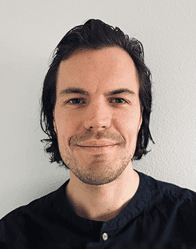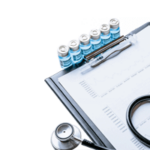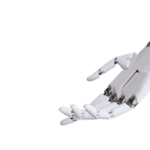Season 1 – Episode 17 – Ethical Considerations for Artificial Placenta and Womb Technologies
Discusses artificial placenta and womb technologies, including some ethical considerations for first-in-human clinical trials.
Episode Transcript
Click to expand/collapse
Daniel Smith: Welcome to On Tech Ethics with CITI Program. Our guest today is Stephanie Kukora, who is an assistant professor of neonatology and bioethics in the Department of Pediatrics at Children’s Mercy Hospital. Stephanie’s areas of expertise include neonatal, perinatal medicine, physician, patient relations, bioethics, and clinical decision making. Today, we are going to discuss artificial placenta and womb technologies, including some ethical considerations for first in-human clinical trials. Before we get started, I want to quickly note that this podcast is for educational purposes only. It is not designed to provide legal advice or legal guidance. You should consult with your organization’s attorneys if you have questions or concerns about the relevant laws and regulations that may be discussed in this podcast. In addition, the views expressed in this podcast are solely those of our guests. And on that note, welcome to the podcast, Stephanie.
Stephanie Kukora: Hi. Thank you so much for having me.
Daniel Smith: Absolutely, and I’m very much looking forward to our conversation today. So to get started, tell us more about yourself and what you currently focus on.
Stephanie Kukora: So I am a neonatologist in practice. So I’m a physician who cares for critically ill newborns, and that includes caring for them in the NICU and also providing things like antenatal counseling to families when they’re faced with a baby who’s anticipated to need extra help after being born. I also help with things like end of life care and bereavement care for babies who aren’t able to survive. And I previously did some follow up of babies who’d been in the NICU to see how they did in the long term, but less of that these days. I also serve as a bioethicist, and so that includes doing things like clinical ethics consultation and being part of the ethics committee at the hospital.
But I think my primary work includes doing research on ethical issues that arise in neonatology and specifically in engaging parents in difficult decisions, in complicated communication around difficult news, things like that. I also do some global health work a little bit on the side, but I do want to clarify that I’m actually not a researcher in artificial womb or artificial placenta technologies. I know some folks who do that. They’re very smart people. That is not actually something that I do personally.
Daniel Smith: So we are here to talk about artificial placenta and womb technologies, and we’ll just do a brief overview of the technologies as I know you mentioned that this isn’t your area of research, but more your area is the ethical considerations that go into this. So ultimately that’s what we’re getting to. But to start, can you just provide a brief overview of the artificial placenta and the artificial womb and why there is a need for these technologies?
Stephanie Kukora: Yeah, so these technologies basically are designed to provide an alternative treatment to conventional NICU therapy for babies who are born extremely prematurely. And by that I mean babies born at about 22 to 24 weeks gestational age, which a typical pregnancy is about 40 weeks long. So as you can imagine, these are just about halfway done and come out and their lungs are really not well-formed at that point. And there are a lot of risks of caring for babies that early. Specifically that the ventilators that we have cause damage to very premature lungs that causes long-term scarring, and they can end up with things like bronchopulmonary dysplasia or BPD, which is a long-term pulmonary complication of being born very early and needing the ventilator.
So artificial placenta and artificial womb technologies basically try to mimic the environment when the baby is still on the inside, meaning that the gas exchange does not happen in the lungs like the placenta does the gas exchange while babies are still on the inside. And so instead, with these technologies, the blood actually flows outside of the body and the carbon dioxide is removed and the oxygen is added using a membrane oxygenator. This is similar to extra corporeal membrane oxygenation or ECMO, which we currently use in neonatal and other patients in ICUs. It’s also similar to the technology that is needed when patients undergo heart surgery and need to be on the heart lung bypass for a prolonged period of time while the surgeons are operating.
Daniel Smith: I think that’s a really helpful overview, and I know that the work done to develop these technologies has been done in sheet models and there’s some other emerging work using smaller models. Can you tell us about some of the findings from these preclinical studies, particularly as they relate to the safety and efficacy of these technologies?
Stephanie Kukora: So work thus far, as you noted, has been done in things like sheet models. And I know that there’s one system called EXTEND that is being primarily worked at the University of Pennsylvania and Children’s Hospital of Philadelphia. And that’s been supporting sheet models for I think up to four weeks on these technologies. The artificial placenta, there’s a model being developed at the University of Michigan and that’s been supporting these fetal lambs for around two weeks. These are probably the two closest to development in human trials. They’re a little bit different from one another in terms of the technology. The EXTEND has a bio bag and the artificial placenta does not, but both of them have been largely worked on in fetal lambs. But fetal lambs are actually pretty different from humans. They’re much larger, they’re about five times bigger. So a human baby at about 23 weeks gestation is about 500 grams while a lamb who is at what is considered an equivalent gestation since the gestation times are different between the two is about two and a half kilos.
They have been looking at smaller animals more recently. But the bigger issue really is that species develop differently in the womb. As I said, there’s usually a different gestational time for any different mammals’ gestation. I think elephants have really, really long ones much longer than humans, and human brains are actually notoriously behind other mammals because we don’t actually learn to walk for about a year after being born. Whereas most other mammals like lambs can walk on day of life one. And I think that this raises some important questions about whether the complications that might occur might occur the same way. The lambs’ gestation for these trials is chosen based on their lung physiology, they want the lungs to mimic babies who are born at 22 to 24 weeks gestation. On the other hand, their brain development might be much farther along than a human baby at 22 to 24 weeks. And what this means for complications like brain bleeds, which is one of the most serious things that can happen when babies are born super prematurely, it makes it largely unknown how this is going to translate across into humans.
Daniel Smith: I know you mentioned those two examples are possibly the furthest along. So do you have a sense of how close we are to first in-human clinical trials involving artificial placentas and wounds?
Stephanie Kukora: That is a little hard to say at this point. I know that FDA approval might be being sought by some of the groups that are working on these. I’m really optimistic. I mean, this would be a tremendous technology for neonatology in general, that this could maybe be available in the next one to two years. But I think it’s really hard to predict what the timeline might be for these. But we hear that it’s coming up, it’s coming close.
Daniel Smith: Wonderful. And I think that is also really helpful context, gives us all a better understanding of these technologies and some of the work that has been done in preclinical models and where we’re headed. So I know you and some colleagues recently published some recommendations to guide the ethical design of these types of trials. And before we get into some of those recommendations, can you talk about some of the unique risks associated with the artificial placenta and the artificial womb?
Stephanie Kukora: So these are interesting new technologies and as we know with any brand new technology, there are risks that we can kind of expect and then there are risks that we might not be able to anticipate. So there could be total wild cards out there that we just have no idea because we’ve never tried to put a human baby on an artificial placenta before. There are of course risks that the technology just might not work, it might not achieve the goal. The lungs might still not develop correctly, the baby might still be at higher risk of the complications typical to prematurity. There are risks that it just might not be even feasible to cannulate a human in this way, damage in cannulating these little vessels. The EXTEND system I think uses the umbilical vessels, whereas the artificial placenta for Michigan I think uses other vessels in the body and what the different risks might be between trying to put these plastic cannulas into these vessels so early in life, we’re not really sure.
I think a big one is the risk of bleeding. As I noted before, when a baby is born prematurely, the blood vessels in their brain aren’t very well-formed and they have risk of bleeding into their brains. And this is actually one of the most serious outcomes for babies and can lead to long-term neurodevelopmental impairment. I think anything that considers anticoagulation in a baby born this early poses a risk of causing some of these brain bleeds. I think that the EXTEND system has been working largely with heparin circuit, which is similar to ECMO that we use in term newborns now. And I think that the Michigan system is working on developing a new nitric oxide based anticoagulation therapy for them. But that also has not been tested at all in humans at this point. There’s also risks of infection, right?
So a lot of babies born extra prematurely can have bacterial infections. That’s a lot of where our mortality can come from. And so here’s a baby we don’t really know is being outside of a biobag or inside of a biobag. Something that can cause infection is having the lungs filled with fluid rather than ventilated through a mechanical ventilator, preventing those ventilator associated pneumonias or harboring bacteria that can grow in those fluids in there. There have also been some talks about what about the risk of things like poor parental bonding while in a biobag or having this baby feel like they’re so technologically supported, and what does this mean to parents who are in the situation of seeing their babies this way? I think that there’s a lot of different directions that could have risks in this situation.
Daniel Smith: I want to take a quick break to tell you about CITI Program’s Healthcare Ethics Committee course, which addresses many common issues encountered in clinical ethics, including informed consent, advanced directives, decision-making for capacitated and incapacitated patients, end of life issues, medical confidentiality, neonatal and maternal fetal ethics and allocation. You can learn more about this course and others at citiprogram.org.
Now, back to the conversation with Stephanie. When it comes to future clinical trials involving these technologies, what are some of the ethical issues that will need to be considered and how could they be addressed?
Stephanie Kukora: So I think that some of the first important questions are sort of trying to figure out who the right first patients will be, first human patients because there are a lot of risks and benefits to be weighed around this. Right now, the population that this is intended for overall have what I would say are poor outcomes but not dismal outcomes. I think that the most recent studies of how preemies that these gestations do in the long term show that about almost… I think it’s about 20 to 30% of 22 weekers and almost half of 23 weekers now survive. And of those, those who survive, only about 50% have long-term complications of being born so prematurely. Now only 50%. That means 50% do and what you take of those outcomes is a lot based on what you think about what an outcome like that quality of life could mean in the long term.
But I think what we do know from general patients who are born this prematurely is that we have population data for like what, a hundred similar infants with some of these same characteristics, gestational age, boy or girl, whether the mom got steroids, if the baby’s well grown or growth restricted. We know what a spectrum of babies with those characteristics will do. How many will survive, how many will die, how many will have long-term impairment? But we can’t predict for any one individual baby what their outcome is going to be before they’re born. And so this is going to suddenly place the situation where we’re comparing, we’re looking at these sort of population outcomes and what could happen for this baby and with conventional therapy and then weighing that against this completely unknown risk of these new technologies. The artificial placenta system that’s being developed at Michigan can be used as a rescue.
So once the patient is failing conventional management, they can be cannulated on at that point or they can be decided to do it right at birth. But the artificial womb EXTEND technology requires actually a mom undergo a C-section and then plan for immediate cannulation. So there’s this risk of putting on babies who would have done well with conventional therapies right on. And then I think that that also leads to the next big issue, which is getting informed consent that is not biased. I would say that this is already one of the hardest conversations we ever have in neonatology, talking to a family before a baby is born, when that baby is expected to be extremely premature. Like I said, we have these population data and we can talk to families about what the chances are of surviving or not surviving and having long-term impairments. And then usually we talk about with the families like what these different outcomes could mean to them and what kinds of things we’re going to do in the delivery room.
Are we going to provide intensive care? Are we going to focus on comfort and a short period of time? And are there limits? Is there a point where we might change course if we think that things are not going well, and so now we’re taking this conversation, adding this totally new other option that it’s itself technically complicated to explain, right? We could do this other thing where we don’t use your baby’s lungs and we support them through this membrane oxygenator. I mean, my goodness, what a complicated thing to hear about. And help engage parents and hope that they make the decision that makes sense for them and that is right for them and their family. Many people saw the video on social media of the lamb in the EXTEND system, in the artificial womb biobag. It had music playing. It looks like this magical technology. I can imagine for a parent who’s emotionally overwhelmed facing a situation where their child might not survive, that this might sound like this fantastic opportunity.
But at the same time, we know from the support trial in neonatology that sometimes parents agreed to trials saying that they understand the risks, but if their child has a poor outcome, they might look back with regret and say that maybe they didn’t understand this and that they wish their child hadn’t been placed at higher risk due to a study. And then the last piece is the idea of this risk of a C-section to the mother. So at this gestation C-section is done actually differently than it’s done at term. It’s a classical cesarean section or the incision to the uterus runs vertically up and down and into the muscular area because the uterus has not expanded enough at this point to do the low transverse incision.
And why that’s important is that once the muscle has been incised there, it never quite heals up the right way. And for all subsequent pregnancies, there’s a risk of continuing the pregnancy to term, a risk of uterine rupture, which is a serious emergency. And so most people who’ve undergone a classical C-section have to have premature deliveries in the future with subsequent children. And as you can imagine, that’s a big trade-off if the baby that you’re having right now has a high risk of not surviving, making a choice like this can impact your ability to have children in the future.
Daniel Smith: And are there other issues that need to be addressed when planning clinical trials involving artificial placentas and wounds? And if so, how could those be addressed by researchers and others?
Stephanie Kukora: So I think also designing a trial so that we get useful information that can guide us clinically. We don’t want to dismiss a useful technology because we only tested on patients who are too sick to benefit. But again, as I said before, there’s also a lot of worry about trialing some otherwise untested therapy on a patient who would have otherwise done well on conventional therapy. So trying to figure out how we can stratify to the risk of different patients to sort of find the right first patient. We also want to enroll enough patients that the safety and efficacy can be determined with confidence so that we know that it’s really, really safe.
But we also don’t want to delay its application if it’s clearly better than the conventional. So being thoughtful about how big does this trial have to be to ensure that it’s safe. Historically when extra corporeal membrane oxygenation or ECMO therapy was piloted, this was actually done also at the University of Michigan. They sort of started with very, very ill patients in a non-trial. And then when they went to a randomization trial, they tried this approach that’s called Play the winner, which is a kind of interesting way to randomize, which basically the point of it is that you don’t enroll a lot of patients to the arm, that is worse. And so basically if you have a good outcome, you keep using that one. If you have a bad outcome, it switches to back to being a coin flip, which arm you end up in. And so in the first ECMO play, the winner trial, there was only one patient that was randomized to the conventional therapy for at that point persistent pulmonary hypertension.
And that was because the ECMO therapy worked so well. It saved so many of these babies who had a really high mortality rate, but unfortunately, a lot of experts really dismissed this right when it first came out that this trial wasn’t really well done. They didn’t really believe it. There are commentaries about it, and I think that that in the end probably delayed its application to be more widespread and perhaps a different trial design could have resulted in more widespread use and saving more babies sooner.
Daniel Smith: So that’s a lot of really critical considerations that you just brought up. So currently, what resources are available to help folks navigate and better understand these issues?
Stephanie Kukora: Well, I think for obvious reasons, oversight from institutional review boards and things like the FDA are really important in guiding these initial trials to ensure safety, that the harms are minimized to the research subjects and so on. I think there also may be a role for people like community stakeholders, parent representatives, and advisory boards, it could be included in the design of these trials to ensure that those perspectives are included. I think that this reduces the risk that this is a physician designed trial, and here it’s up to the parents to understand the trial and agree or not agree at the time under their stressful situation. I think that having more input from parents to say, “This is a reasonable study. If I were in this situation, I would think that these risks and benefits would be reasonable or not,” could help guide this. I think that this is really important because this is going to be a really high profile clinical trial and if it’s unsuccessful or parents worry in retrospect that their children were harmed by participating, this could do a lot of risk to public trust if research in the future.
Daniel Smith: Absolutely. And I guess on that note, do you have any final thoughts you would like to share that we’ve not already touched on?
Stephanie Kukora: I guess if I wanted to say one more thing is that the first in human trials are really some of the first ethical barriers we have with this technology and that there will be more ethical issues to come. I think once we demonstrate that it’s safe and efficacious, then there might be questions about who gets this technology, not only which NICUs are able to do it, but who of the patients who come in, how can we ensure that it would be equitable between patients? What kind of consent to care with this modality, not just research but doing this for your baby? How much will we have to get parents’ consent to use this technology after it’s been approved? And what are the costs of this compared to conventional therapy? I can imagine that this is, in the long term, quite expensive, and I think it depends a lot on what outcomes we are trying to adjust here.
I think if this really improves survival, that’s great. If it improves survival, but also leads to more brain bleeds, I don’t know that that’s a win. I think having reduced bronchopulmonary dysplasia because of the lungs not being used, that’s great for kids who end up on mechanical ventilators, but I’m not sure if that really makes a difference for the kids who end up just needing nasal cannula for a few extra months. So I think there’s going to be a lot of interesting ethical directions to go with this, thinking about what this technology can change and what makes sense from a value standpoint for these patients and for society.
Daniel Smith: Thank you again, Stephanie. That is all for our conversation today.
Stephanie Kukora: Thank you. I really appreciate it.
Daniel Smith: I also invite everyone to visit citiprogram.org to learn more about our courses and webinars on research, ethics, and compliance. You may be interested in our Bioethics course, which reviews contemporary bioethics issues such as ethics and clinical practice for pediatrics and adults, reproductive ethics, genetics and ethics and more. And with that, I look forward to bringing you all more conversations on All things tech ethics.
How to Listen and Subscribe to the Podcast
You can find On Tech Ethics with CITI Program available from several of the most popular podcast services. Subscribe on your favorite platform to receive updates when episodes are newly released. You can also subscribe to this podcast, by pasting “https://feeds.buzzsprout.com/2120643.rss” into your your podcast apps.
Recent Episodes
- Season 1 – Episode 16: Privacy and Ethical Considerations for Extended Reality Settings
- Season 1 – Episode 15: Considerations for Using AI in IRB Operations
- Season 1 – Episode 14: Recent Developments in AI Regulation
- Season 1 – Episode 13: Impact of Generative AI on Research Integrity
Meet the Guest

Stephanie Kukora, MD, FAAP – Children’s Mercy, Kansas City
Stephanie Kukora is a neonatologist and bioethicist at Children’s Mercy Kansas City, where she serves as core faculty in Certificate Program in Pediatric Bioethics. She conducts research related to shared decision-making, global health, and education targeting communication skills for clinicians.
Meet the Host

Daniel Smith, Associate Director of Content and Education and Host of On Tech Ethics Podcast – CITI Program
As Associate Director of Content and Education at CITI Program, Daniel focuses on developing educational content in areas such as the responsible use of technologies, humane care and use of animals, and environmental health and safety. He received a BA in journalism and technical communication from Colorado State University.











